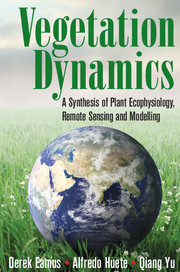Book contents
- Frontmatter
- Contents
- Preface
- Section One Plant Ecophysiology
- Section Two Remote Sensing
- 4 An Overview of Remote Sensing
- 5 Fundamentals and Physical Principles of Remote Sensing
- 6 Satellite Sensors and Platforms
- 7 Remote Sensing of Landscape Biophysical Properties
- Section Three Modelling
- Section Four Case Studies
- Index
- References
4 - An Overview of Remote Sensing
from Section Two - Remote Sensing
Published online by Cambridge University Press: 05 June 2016
- Frontmatter
- Contents
- Preface
- Section One Plant Ecophysiology
- Section Two Remote Sensing
- 4 An Overview of Remote Sensing
- 5 Fundamentals and Physical Principles of Remote Sensing
- 6 Satellite Sensors and Platforms
- 7 Remote Sensing of Landscape Biophysical Properties
- Section Three Modelling
- Section Four Case Studies
- Index
- References
Summary
Introduction
The surveillance of the Earth and its terrestrial and aquatic ecosystems, land use activities and snow and ice cover constitute the broad framework of ‘remote sensing’, defined as discerning information about the Earth's surface from afar without direct physical contact. Remote sensing employs non-destructive measurement techniques for monitoring the Earth's structurally and functionally diverse landscapes in a consistent and robust manner.
From early days, aerial photography from balloons and airplanes was widely adopted for its synoptic viewing of vast and often inaccessible areas. This greatly facilitated spatial surveys and monitoring of our ecosystems, soils, hydrologic features and land cover conditions. Today we routinely observe the entire Earth as a planet utilising spacecraft sensors that circle the Earth every 90 minutes and remote sensing technologies have become widely integrated within ecosystem sciences and agriculture and natural resource management communities (Kerr and Ostrevsky 2003).
Satellite data offer unprecedented capabilities to capture spatial and temporal details of dynamic ecosystems, functional processes and characterisation of ecosystem structure and biological properties (Pettorelli et al. 2005; Glenn et al. 2008). When properly integrated with ecological principles and models, remote sensing is a powerful tool for landscape process studies, ecosystem assessments of health and productivity and vegetation -climate interactions at local-to-global scales. This has enabled new discoveries about our planet and has improved our understanding of its state, health and functioning (e.g. Lefsky et al. 2002, Tucker et al. 2005; Fig. 4.1).
In this book the principles of remote sensing and their application to ecophysiological and environmental studies are coupled to modelling of landscape-atmosphere interactions within the Earth science community. We address the recent challenges in biosphere science, climate change, diminishing biologic diversity, large-scale droughts and land sustainability. These issues have exerted increasingly complex demands for more quantitative, longer-term and accurate satellite-based remote sensing data to better diagnose ecosystem health and status and assess how the Earth is changing over time (Fig. 4.2).
A Framework of Remote Sensing
Remote sensing encompasses a multitude of activities that include the development, operations and calibration of satellite sensor systems; data acquisition and storage; image interpretation and analyses; and visualisation of spatial data.
- Type
- Chapter
- Information
- Vegetation DynamicsA Synthesis of Plant Ecophysiology, Remote Sensing and Modelling, pp. 155 - 166Publisher: Cambridge University PressPrint publication year: 2016



